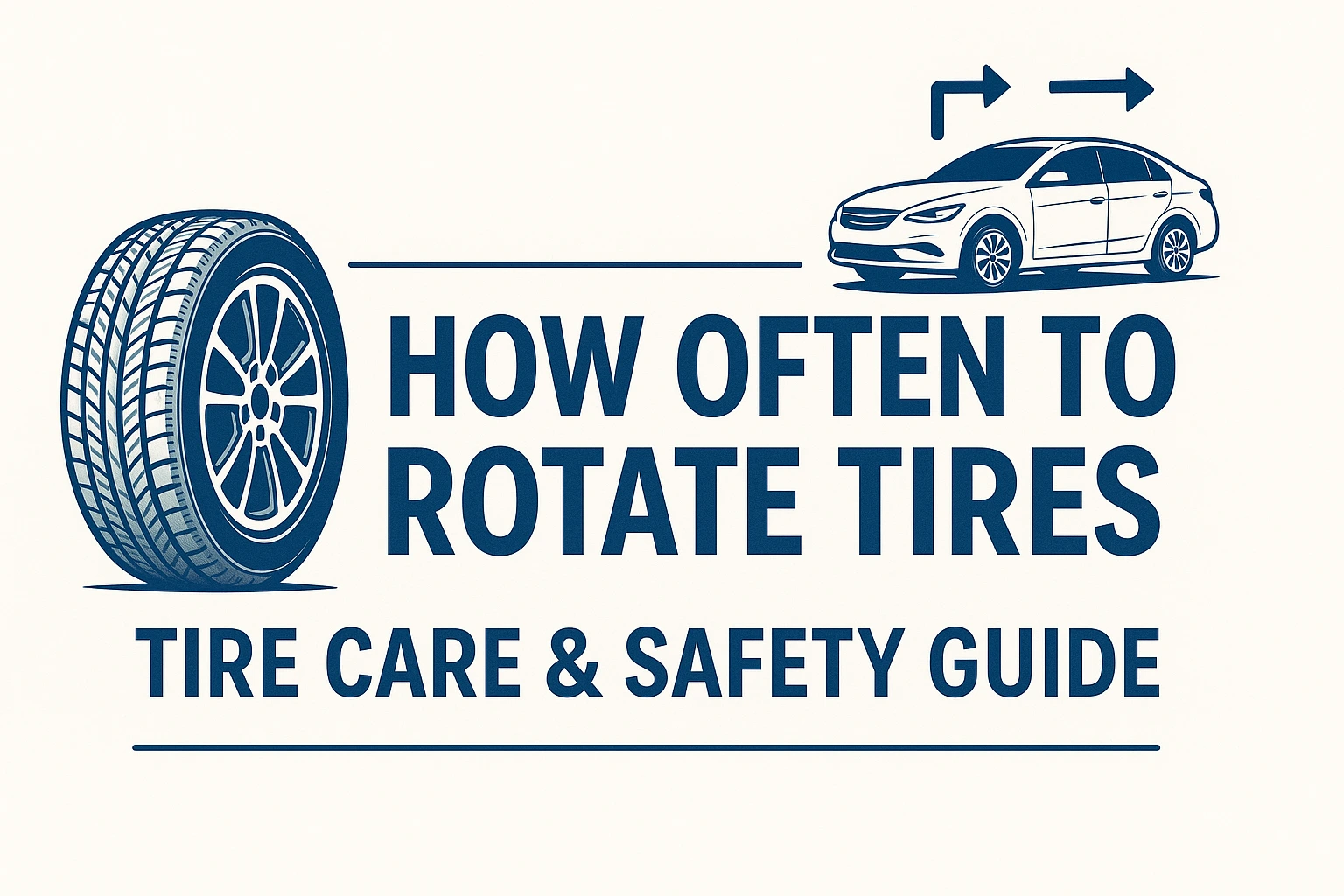Introduction – How Often to Rotate Tires?
Keeping your car tires in good shape is not just about checking air pressure or buying new sets; it’s about regular care that extends their life and keeps driving safe. Tire rotation helps balance tread wear so your vehicle handles smoothly on every road. For drivers wondering how often to rotate tires, the answer depends on your vehicle type, mileage, and road conditions. According to AllWorldwideNews, paying attention to these details can save money, improve fuel efficiency, and reduce the risk of premature tire wear.
What Is Tire Rotation?
Tire rotation means moving your car tires from one position on your vehicle to another at regular intervals. The goal is to rotate your tires every 5,000 miles to ensure optimal performance. so that tread wears evenly, whether your vehicle has a front-wheel drive, rear-wheel drive, or an AWD drivetrain, and to know how many miles to rotate tires. Without proper rotation, the front tires or rear tires may wear out more quickly, reducing safety and comfort. Regular tire rotation improves handling, extends the life of your tires, and keeps performance consistent on different road conditions.
Benefits of Tire Rotation
- Longer tire lifespan can be achieved by getting your tires rotated regularly.
- Even tread wear
- Safer driving performance
- Better fuel efficiency
Why Tire Rotation Matters for Your Car Tires
When you don’t rotate tires on time, uneven tire wear can show up quickly. Front tires often carry more load in FWD vehicles, while rear tires in RWD setups may wear differently. With AWD cars, all four tires need balanced care since the drivetrain distributes power evenly. Ignoring this can shorten the life of your tires and make driving less safe.
Tire Wear and Safety
Worn tires reduce traction, increase braking distance, and affect stability on wet or rough roads.
Saving Money on Tire Care
Regular tire rotation prevents early replacements, helping your car tires last longer and saving money.
How Often Should You Rotate Your Tires?
Drivers often ask how often to rotate tires, and the answer depends on your vehicle type and driving style. In most cases, a tire rotation schedule of every 5,000–7,500 miles works best. Since front tires in FWD vehicles wear out quicker, they need more attention. In rear-wheel drive cars, the rear tires carry greater stress, while tires on the same side wear unevenly. AWD vehicles demand even more frequent checks due to equal power distribution across all wheels. Regularly rotating your tires keeps tread balanced, improves performance, and extends the overall life of your tires.
| Vehicle Type | Recommended Rotation Interval | Notes |
|---|---|---|
| FWD | 5,000–7,500 miles | Front tires wear faster |
| RWD | 5,000–7,500 miles | Rear tires balance needed |
| AWD | 3,000–5,000 miles | Rotate more often for even wear |
Tire Rotation Patterns Explained
Different vehicles require unique tire rotation patterns, such as AWD tire rotation or RWD tire rotation. tire rotation patterns to keep tread wear balanced. Following the right method ensures even wear on all car tires and supports better handling.
Front-Wheel Drive (FWD) Rotation Pattern
In FWD cars, the front tires wear faster. The common method is moving them straight to the back, while the front tires to the back method is also effective. rear tires cross to the opposite sides in the front.
Rear-Wheel Drive (RWD) Rotation Pattern
For RWD vehicles, the rearward cross is used. The rear tires move straight forward, and the front tires shift diagonally to the back for an AWD tire rotation.
All-Wheel Drive (AWD) Rotation Pattern
AWD vehicles often need an X-pattern or four-tire cross. This keeps tread wear even since power is distributed across all wheels.
Signs You Need a Tire Rotation
Recognizing the signs of uneven tire wear can help you schedule a tire rotation before bigger issues arise, such as needing a full rwd tire rotation. When car tires are not rotated regularly, they lose balance and affect performance. Drivers should always check tread depth and look out for changes in handling. If you notice any of these warning signals, it’s time to rotate your tires and restore even wear.
- Uneven tread wear can be minimized by rotating your tires every 5,000 miles.
- Vibrations while driving
- Reduced fuel efficiency
- Increased road noise
Regular rotation ensures smooth driving and helps extend the life of your tires.
Schedule a Tire Rotation – When to Get Them Rotated
Scheduling a tire rotation is part of smart car maintenance that saves money in the long run. Ideally, you should book a tire service every 5,000–7,500 miles or as suggested in your vehicle manual. Staying on schedule prevents uneven tire wear, improves safety, and avoids costly replacements.
Just like learning how much brokers charge to sell a business, knowing when to schedule a tire rotation helps avoid extra costs and ensures long-term benefits. A timely check not only keeps your tires in balance but also improves fuel efficiency, stability, and overall driving comfort.
Tire Rotation vs. Tire Alignment – Key Differences
Many drivers confuse tire rotation with tire alignment, but both are very different tire services. Tire rotation is about moving tires around the vehicle to ensure even wear, especially when you get your new tires. tread wear, while tire alignment involves adjusting your car’s suspension for proper wheel angles. Knowing the difference helps you maintain safety, reduce costs, and extend tire life.
Tire Rotation
This service involves shifting tires front-to-rear or side-to-side. The goal is to balance tire wear, improve fuel efficiency, and extend lifespan.
Tire Alignment
Here, mechanics adjust suspension angles like camber, toe, and caster. Proper alignment ensures your car drives straight, improves handling, and prevents premature tire damage, which is crucial for new tires.
Tire Inspection and Care Tips
Proper tire inspection keeps your vehicle safe and helps avoid costly repairs. By checking tread depth, monitoring air pressure, and spotting early damage, you extend tire life and enjoy smoother rides.
Checking Tire Tread Depth
Use the simple coin test or a tread depth gauge to confirm your tires have enough grip for safe driving.
Maintaining Tire Pressure
Always follow the manufacturer’s recommended PSI levels. Correct tire pressure improves fuel efficiency and prevents uneven wear.
Regular Tire Inspection
Inspect sidewalls for cracks, bulges, or cuts. Early detection of tire wear issues helps avoid blowouts and ensures safer performance.
FAQs About Tire Rotation
How often should I rotate my tires?
Most vehicles need a tire rotation every 5,000–7,500 miles, but check your owner’s manual for exact recommendations.
Can I rotate my tires at home?
Yes, if you have the right tools, you can rotate tires at home. However, a professional ensures correct patterns and safety.
What happens if I don’t rotate tires?
Skipping rotations leads to uneven tread wear and can shorten the lifespan of your new tires. uneven tread wear, poor handling, reduced fuel economy, and shorter tire life.
Do AWD vehicles require more frequent rotation?
Yes, AWD systems demand rotation every 3,000–5,000 miles to keep tread wear even across all tires.
How can I know if my tires are due for rotation?
Watch for vibrations, uneven tread depth, or increased road noise, all signs your tires need attention.
Conclusion – Keep Your Tires Rotated for Safety and Longevity
Regular tire rotation is one of the simplest steps to protect your car and your wallet. By keeping tread wear even, you’ll enjoy safer handling, smoother rides, and longer-lasting tires. Whether you drive FWD, RWD, or AWD, scheduling rotations on time helps avoid costly repairs and keeps fuel efficiency in check. Stay consistent with your maintenance routine, and your tires will return the favor with durability and performance mile after mile.













